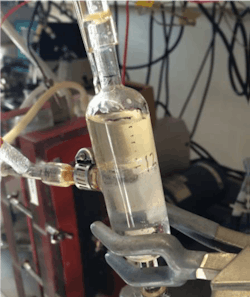Researchers look to convert dairy wastewater to animal feed, aviation fuel
TÜBINGEN, DEC 14, 2017 -- Scientists have developed a bioprocess that enables conversion of acid whey, a dairy by-product, without the use of additional chemicals. Professor Lars Angenent from the Center of Applied Geosciences at the University of Tübingen and international colleagues used microbiome cultures similar to those in the human gut. The new bio-oil can be used in animal feed or, after further refinement, as a fuel for airplanes. The results of the study were published in Joule, a new journal from CellPress.
Every liter of milk that goes into milk products, such as quark and Greek yogurt, or into fresh cheeses, produces another two liters of wastewater in the dairy factory. This wastewater is called "acid whey" and cannot be fed to animals in large quantities due to its acidity. It is rich in organic material like lactose and must be treated or transported to farms for use as a fertilizer by spreading it on land.
Read more on WaterWorld.com
In a Dairy Far, Far a Whey...
Halydean Dairy Corp. to begin trials on dairy wastewater treatment
Dairy faces $70,000 in wastewater fines
Lars Angenent, Humboldt Professor for Environmental Biotechnology at the University of Tübingen, studies how these large volumes of wastewater can be turned into valuable products. He used a tank with many different types of bacteria, called a reactor microbiome. "This microbiome is an open culture, which means bacteria from the outside environment can also enter and grow, similar to our gut microbiome. No sterilization of the tank or wastewater is necessary," he explains. "The bacteria are selected and tricked to elongate the carbon backbone of chemicals by a process that we call chain elongation."
Angenent explains the process: "We kept two microbiomes under different temperatures and placed them in series. The first hot microbiome (50 degrees Celsius) converts all the sugars into an intermediate acid ‒ the same acid that makes milk in your fridge taste sour if you keep it there too long. The second warm microbiome (30 degrees Celsius) performs chain elongation until a product is formed with six to nine carbons in a row." Angenent's research group for Environmental Biotechnology furthermore investigated which bacteria had grown in the two different microbiomes.
"The new product could be fed back to the animal as an antimicrobial to prevent disease, or it can be further processed in a refinery into aviation fuel," Angenent says. Because the product from the bioreactor microbiome has six to nine carbons in a row, it becomes more oil-like and can be separated from the water it was produced in. After that it must still be purified and further refined. "We are making a bio-oil that the bacteria excrete," Angenent says. "The innovation of the research is that the process does not need any other carbon-rich chemicals and only needs the waste water itself. In the past, chain elongation needed external, expensive chemicals."
The production of bio-oil is part of the development of a circular economy, in which all wastes are recycled into valuable products. "Only a completely circular economy can be sustainable with all energy coming from renewable sources, while carbon for chemicals is coming from waste CO2 and other carbon-rich wastes such as acid whey," Angenent concludes. More work is now needed to study if other types of wastewater can also be converted into these valuable chemicals.
